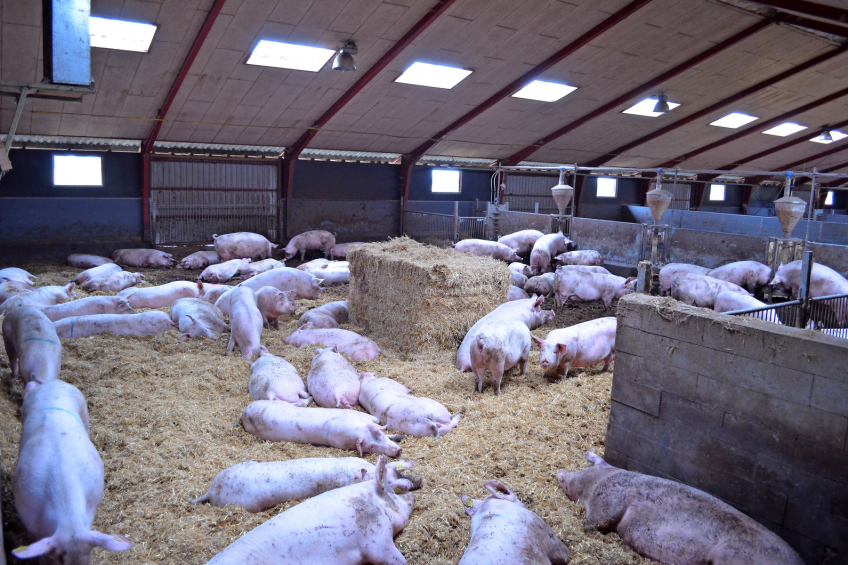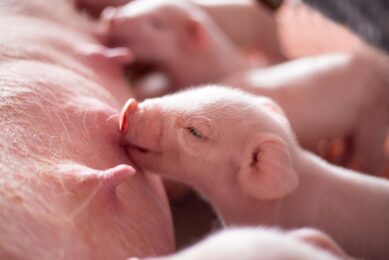Striving for more than 35 piglets per sow per year

What good genetics and highly motivated staff can lead to is shown by Tom Oestrup – at his farm on the Danish island Funen. Last year he weaned 35 piglets per sow per year – and this year the target is up again.
Denmark prides herself on her pig industry and rightly so. For a nation of 5 million people the country punches well over her weight. The country’s DanAvl breeding organisation is aggressively exporting stock all over the world and their booths feature predominantly at all the major pig salons around the globe. DanAvl stock are noted for their prolificacy and that is naturally a feature of the stock on Danish farms. Physical output, though, is one thing but must not be at the expense of profit. Managing hyperprolific sows takes a lot of time, and time is money.

Baekgaarden Farm, key data
Breeding unit (Broby)
Sows & gilts: 700
Average born alive per litter: 16.1
Average reared/ litter: 14.9
Pre-weaning mortality: 7.4%
Weaning age: 27 days
Weaning weight: 5.4 kg
Litters/sow/year: 2.39
Pigs weaned/sow/year: 35.5
Growing unit (Eskebjerg)
Weight range: 6-30 kg
Mortality: 2.4%
ADG: 460 g
Tom Oestrup, 42, is a highly motivated young farmer running 700 sows near Broby, Funen, Denmark. Baekgaarden is a 700 sow breeding farm which last year weaned about 35 pigs per sow per year, despite having mycoplasma problems in 2008, which again flared up in 2011. Oestrup suspects the infection was windborne as Denmark is a very windy country and the nearest neighbour’s pigs are just 1.5 km away. Baekgaarden is a Specific Pathogen Free (SPF) unit, which means that the farm is free of several diseases. The SPF list includes seven diseases, although not every SPF farm has to be free of all.
The farm has 190 ha of arable land growing wheat, barley, rape and grass, the cereals providing 90% of the unit’s feed needs. Piglets are weaned at four weeks and then moved to the 3,500 place Eskebjerg site, which is about 1.5 km from Baekgaarden.
They stay there until they reach a weight of 30 kg. The pigs are then sold on to other farms for finishing.
Staff
Diligent, motivated and enthusiastic employees are the key to success, states Oestrup. He employs one Danish employee, who is in charge of the mill and mix unit and the arable work. He also employs four Ukrainians; two of which had been trained as veterinary assistants in Ukraine prior to moving to Denmark for a better life and more money through a recruitment company. One is working in the farrowing house, Vitalii; one in the sow and serving areas, Valik. Oestrup also employs two trainees. His key staff are paid 25,000 Danish crowns (€3,350) per month, have housing provided plus free television and internet provision.
Apart from dedicated staff, a highly motivated boss is also a prerequisite for success. Oestrup explains, “As leader, I set realistic targets, sort out personal problems, have complete trust in my staff, attain objectives and show enthusiasm when these targets are reached, respect my staff and appraise them on a regular basis.”

Tom Oestrup: ”Diligent, motivated and enthusiastic employees are the key to success.”
Oestrup and all his staff meet each morning for breakfast at which time the talk is all about football and pigs. Staff are encouraged to discuss problems straightaway and not to let them fester, plus to bring up any suggestions as to how production might be improved. In addition, the team holds a meeting each Wednesday which focuses on sow and gilt performance. All the data is recorded on a large white ‘motivation’ board. Good data are in green, with bad in red, so that Oestrup can see at a quick glance how his pigs are performing.
Oestrup adds, “We have a productivity target which is re-assessed annually and which starts on New Year’s Day. Targets have to be realistic, so that myself and my staff feel they are attainable. Last year our target was 35 pigs weaned/ sow/ year and we achieved that. This year our target is 35.5.” Oestrup favours using bonuses as an incentive. To work properly, very accurate records need to be kept and the farm has a bullet proof system in that respect. Oestrup is a fan of this motivational concept and his staff got a nice bonus of €1,000 each in 2013.
Sows
Hyperprolific sows must be well fed, in fact some sows can consume 15 kg of feed/ day, in order to give plenty of milk and not lose weight, hence sows are fed three times per day at 7 am, 11 am and 3 pm. Some straw is put into the farrowing pens to let the sows exhibit a degree of nesting behaviour. In the farrowing house the youngest piglets
are always handled first, then the older litters get attended to. The creep feed contains 61% wheat and also includes 2,000 ppm of zinc as a precaution against scouring.
Hygiene is very important with all brushes, shovels etc being cleaned and disinfected after use. Incidentally, the disinfectant changes colour once it is no longer effective.
Oestrup is very proud of his pre-weaning mortality, which is half the national average. Staff always check the farrowing house during the evening, which undoubtedly keeps mortality low.
Baekgaarden has two ‘nursing pens’, each of which house up to 45 piglets not considered big enough to move to the post-weaning accommodation. These pens have creep lamps and ‘artificial sows’ which deliver highly nutritious feed. Whilst the sows are weaning exceptionally good numbers, over 15 per litter, weaning weights average 5.6 kg, which at 27 days is on the low side. Pigs with below average weaning weights are always slower to get to slaughter and it was suggested to Oestrup that installing a milk line would be of benefit, to improve weaning weights.
Weaning
Weaning takes place on a weekly basis with piglets being transferred to the high tech weaner accommodation in Eskebjerg. Strict hygiene is a feature and all pipes and drinkers are disinfected for a 24-hour period. Post-weaning accommodation follows the typical Danish pattern, with pigs housed in groups of 23, graded by size, and floors being semi-slatted. The pigs are kept warm
by means of underfloor heating and a comfort mat is provided under the pen canopy.
The cup drinkers can be tilted to allow for easy cleaning. A pressurised ventilation system is another feature, with the temperature being automatically reduced from 23°C to 18°C over a five-week period.
Insemination and gestation
At weaning the sows are moved to the service stalls and a teaser boar is walked through the central passage allowing snout to snout contact between the boar and the sows. Two inseminations are the norm, 24 hours apart, although some sows may get three services, in which standard catheters are used. Pregnancy scanning takes place at four and six weeks. Oestrup is very proud of the fact that his sows have been loose housed since 1999, with sows kept in groups of 80. Pens are bedded with plenty of straw, which builds up over time and in fact water pipes take heat out of the bedding/ manure, with the heat being used in the farrowing house. Pregnant sows receive feed on ad lib basis. The feeders are fixed in the pen divisions, so that each feeder services two pens.
The Baekgaarden productivity is certainly ‘top drawer’ and hence Tom Oestrup capitalises on his management skills by offering his services as a consultant to other pig producers.
[Source: Pig Progress Vol 30 nr 7, 2014]














